A while ago I wrote about my experiences with seeing colors underwater that human eyes are not supposed to see at depth (
see "Red at Depth). In it I described and showed examples of bright red at depths ranging from 60 to 90 feet when red should disappear at about 20 feet. Upon consultation with a number of experts, most notably Dr. Charles Mazel, I learned that the phenomenon was most likely due to fluorescence. "Fluorescence" essentially describes the physical process of a substance absorbing light at the incoming wavelength, and re-emitting it at a different wavelength.
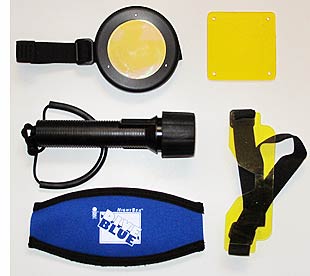 In the process of reading up on Dr. Mazel's research I came across the NIGHTSEA website that deals with underwater fluorescence and offers a variety of special lights and filters to reveal fluorescence and also capture it on camera.
In the process of reading up on Dr. Mazel's research I came across the NIGHTSEA website that deals with underwater fluorescence and offers a variety of special lights and filters to reveal fluorescence and also capture it on camera.
Here's how it works: In order to see fluorescence during a night dive, you need a special type of light that excites/reveals the fluorescence. Mazel, who owns NIGHTSEA, found that a carefully controlled range of blue light works best. However, since the blue light bathes everything in blue, it'd be easy for the fluorescence to be drowned out by the blue light. So you wear a yellow visor over your scuba mask to filter out the blue. This way, you can see the fluorescence very clearly.
To take pictures, you apply a blue filter to the camera's flash, and a yellow filter to the camera's lens. The picture to the right shows the fluorescence hunter's toolkit: a BlueStar flashlight, a yellow visor, a special filter for the flashlight, a yellow filter for the lens, and a slap-strap to secure the visor to the mask strap (and also to keep it from getting scratched when not in use).
Before going into the water, we tested the whole thing at home. We used the fluorescence hunter gear to find some clothing with fluorescence and hung it in a closet. The four pictures below show, from left to right, 1) closet light on, no filter, 2) closet light off, standard white flashlight, 3) closet light off, blue light, 4) closet light off, blue light and yellow lens filter. As you can see, part of the clothing is highly fluorescent, but it takes both the blue light and the yellow lens filter to reveal it.

With that knowledge under our belt, and having travelled to the Honduran island of Roatan with a boatload of other test equipment, we then got ready for our first night dive at CoCo View Resort with the fluorescence hunter gear.
Setting everything up was quite tricky. For our first night dive we chose a review SeaLife DC1400 underwater camera and strobe. It was fairly easy to fasten the blue filter onto the strobe via the filter's adjustable bungee strap. Securing the square yellow acrylic lens to the front of the DC1400 camera was a bit more challenging. However, "Stretch Magic" bead & jewelry cord from the Pepperell Braiding Company in Massachusetts did the trick.
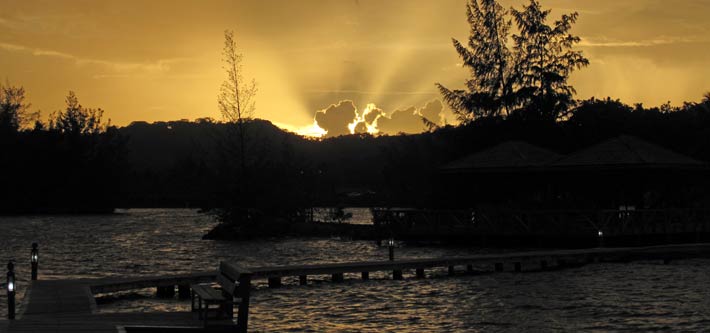
So we waded into the water, got the light and visors to work and were treated to far more fluorescence down there than I'd have expected. It seemed mostly white and slightly greenish, but that may be because of the type and color of light. Those first few instances of fluorescence were a real mind blower!
Unfortunately, we had some startup problems. Floating underwater made it difficult to both hold the flashlight and the camera, and so it was hard to get the camera to focus. We also got inexplicable streaks of light that overpowered the actual image, so eventually we decided to postpone the picture taking and just enjoy exploring the fluorescence. The moon was bright enough for us to see without light and so we spent the dive exploring with the blue light, both of us wearing the yellow visors in front of our masks. We meandered around the CoCo View resort's famous front yard, then moved on to the wreck of the 140-foot Prince Albert where we found quite a bit of fluorescence as well.
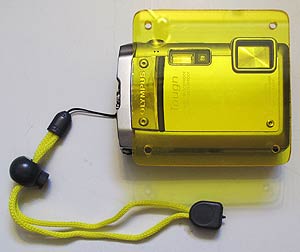 For our second outing we used a much smaller camera, an Olympus TG610, which is waterproof to 33 feet without a housing. We used elastic "Stretch Magic" cord again to secure the yellow acrylic filter plate in front of it. For light we intended to rely not on a flash, but simply on either the blue flashlight or another light with the blue filter in front of it. That was a lot of stuff to carry (in addition to the tags the resort wants for night divers to take along and clip onto a pole with a strobe on it in a very clever arrangement to keep track of divers).
For our second outing we used a much smaller camera, an Olympus TG610, which is waterproof to 33 feet without a housing. We used elastic "Stretch Magic" cord again to secure the yellow acrylic filter plate in front of it. For light we intended to rely not on a flash, but simply on either the blue flashlight or another light with the blue filter in front of it. That was a lot of stuff to carry (in addition to the tags the resort wants for night divers to take along and clip onto a pole with a strobe on it in a very clever arrangement to keep track of divers).
It was another clear night with almost full moon and we hardly needed lights at all underwater. But without a sufficient means of communication, it was hard to coordinate between the three of us, only two of whom wore the yellow visors. I had the camera and the camera clearly saw the fluorescence, but getting pictures seemed impossible. The illuminated night scene setting had far too long an exposure for a camera held by a floating diver. The regular Program setting worked better, but exposure was still too long and the camera had a hard time focusing in the low light.
Then I had an idea: why not use video instead? The TG610 can do 720p video, which is 1280 x 720 pixel, so every frame is about equal to a 1-megapixel snap. I tried that and lo and behold, it worked. So we excitedly played around, hunting for fluorescence, of which there was plenty.
Now that we had more or less figured out how our underwater fluorescence hunter gear worked, we began exploring in earnest, and what we saw blew us away! Giant coral heads that look brownish in daylight and are barely visible on night dives all of a sudden lit up in stunning brightness and color, totally transforming the nighttime underwater experience.
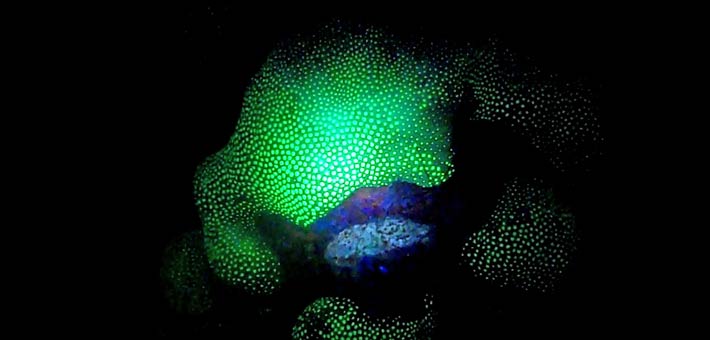
But the big fluorescent coral head was just the beginning. A few yards away from it was a patch of small but intensely fluorescent anemones. They illuminated the dark of the water like psychedelic halloween decorations.
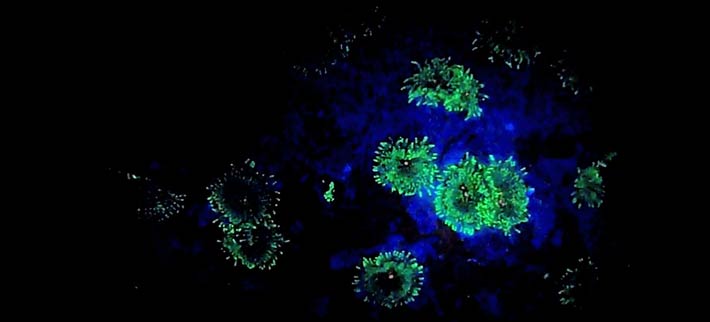
Next we found that larger anemones are also fluorescent! Anemones are fascinating in daylight with their elegantly swaying arms and the numerous colors they come in. Illuminated by the NightSea fluorescent protein flashlight, they revealed a stunning, almost hypnotizing beauty.
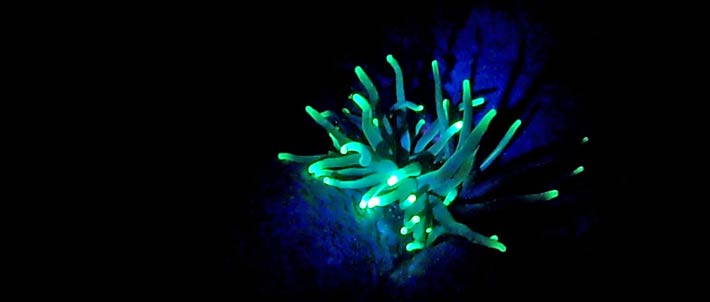
We now began exploring Coco View's shallow (15-25 feet) "front yard" in more detail and it was a stunning, downright magical experience. The underwater world was suddenly divided into things that were fluorescent and things that were not. A lot of coral is fluorescent, but no two corals fluoresce the same. There are different patterns, different degrees of fluorescence, different hues and colors.
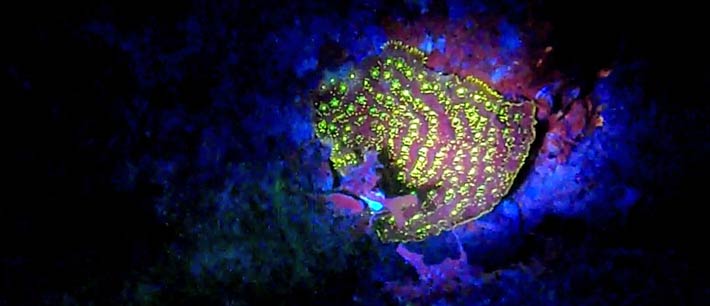
White coral (below left) lights up like a white shirt in a 1970's disco with black light. We saw a lot of that. What we didn't see much were the dreaded blood worms, inch-long critters that swarm around dive lights like buzzing flies. There were some, though, and apparently they are fluorescent as well (see below right).
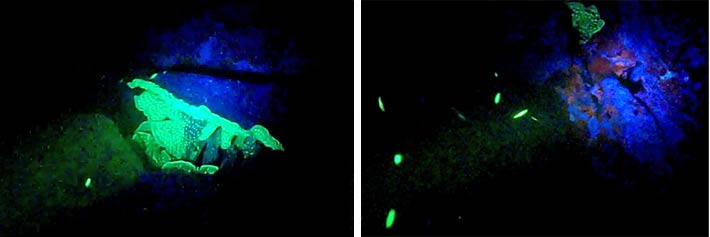
Further exploration showed all soerts of interesting critters. Below, on the left, is some sort of yellow-fluorescent worm (actually the common bearded fireworm, Hermodice carunculata, as Dr. Mazel later pointed out to me), on the right side some sort of coral with spots of strong yellow fluorescence.

Below on the left is another little fluorescent anemone, and then we saw the thing on the right hat looks like a baseball bat half buried in the sand. What it actually is is a sand diver. Sand divers are bottom-dwelling lizard fish that in daylight are so well camouflaged against the sandy bottom that you can barely see them. They just lay there on the sand, virtually invisible. Well, turns out the sand divers are highly fluorescent!
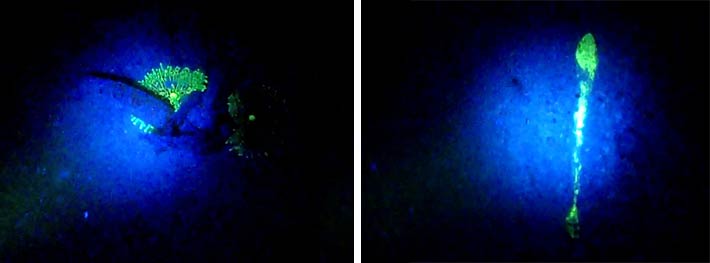
A closer look clearly revealed the sand diver. You can even see that its darker colorings and markings on its skin are not fluorescent whereas the lighter part of the skin is. The sand diver is obviously not aware that it is fluorescent and that we can see it. It made no attemtp at all to flee, apparently feeling secure in being hidden.
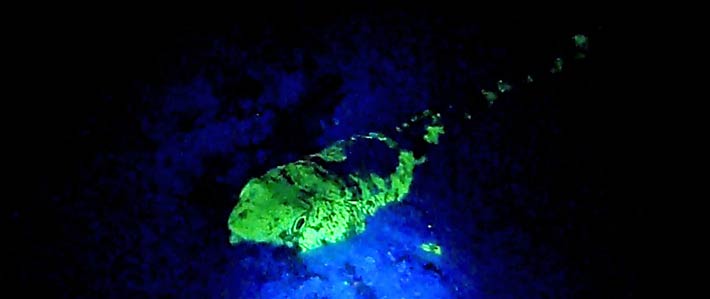
After we had returned back to the room, we eagerly loaded the footage onto my MacBook Pro. Video had worked! It was nowhere near perfect, but the problem was with us more so than with the camera or the fluorescence hunting equipment. We learned that even the one blue light can result in blowouts with too much light, and the blue light cone is quite concentrated so that we often only saw a small area, with the center blown out. We also moved around much too much. With this newfound wisdom we'd love to go back, but this was the last opportunity for a night dive on the trip.
If we get to do it again, it'd be interesting to have a blue light with a wider beam, perhaps a tripod of sorts, and we'll stay on the subject long enough to clearly see what it is and what it does. We'll also record in 1080p, which translates into 2mp stills.
There a, of course, a lot of questions. Why are some critters and substances fluorescent? Why would a sand diver, with its strategy of hiding in the sand, be entirely fluorescent? Why are some corals and not others? Why are some critters not fluorescent at all, even splashy ones like lion fish?
Check out the equipment we used on the NIGHTSEA website or at Backscatter Underwater Video & Photo, which is a NIGHTSEA distributor. We highly recommend this to anyone who enjoys night diving. Exploring the fluorescence down there opens up an entirely new underwater world, one that's endlessly fascinating.










